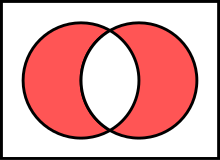Symmetric difference
 | |
| Type | Set operation |
|---|---|
| Field | Set theory |
| Statement | The symmetric difference is the set of elements that are in either set, but not in the intersection. |
| Symbolic statement | |
Inmathematics,thesymmetric differenceof twosets,also known as thedisjunctive unionandset sum,is the set of elements which are in either of the sets, but not in their intersection. For example, the symmetric difference of the setsandis.
The symmetric difference of the setsAandBis commonly denoted by(alternatively,),,or. It can be viewed as a form ofaddition modulo 2.
Thepower setof any set becomes anabelian groupunder the operation of symmetric difference, with theempty setas theneutral elementof the group and every element in this group being its owninverse.The power set of any set becomes aBoolean ring,with symmetric difference as the addition of the ring andintersectionas the multiplication of the ring.
Properties[edit]




The symmetric difference is equivalent to theunionof bothrelative complements,that is:[1]
The symmetric difference can also be expressed using theXORoperation ⊕ on thepredicatesdescribing the two sets inset-builder notation:
The same fact can be stated as theindicator function(denoted here by) of the symmetric difference, being the XOR (or additionmod 2) of the indicator functions of its two arguments:or using theIverson bracketnotation.
The symmetric difference can also be expressed as the union of the two sets, minus theirintersection:
In particular,;the equality in this non-strictinclusionoccursif and only ifandaredisjoint sets.Furthermore, denotingand,thenandare always disjoint, soandpartition.Consequently, assuming intersection and symmetric difference as primitive operations, the union of two sets can be welldefinedin terms of symmetric difference by the right-hand side of the equality
- .
The symmetric difference iscommutativeandassociative:
Theempty setisneutral,and every set is its own inverse:
Thus, thepower setof any setXbecomes anabelian groupunder the symmetric difference operation. (More generally, anyfield of setsforms a group with the symmetric difference as operation.) A group in which every element is its own inverse (or, equivalently, in which every element hasorder2) is sometimes called aBoolean group;[2][3]the symmetric difference provides a prototypical example of such groups. Sometimes the Boolean group is actually defined as the symmetric difference operation on a set.[4]In the case whereXhas only two elements, the group thus obtained is theKlein four-group.
Equivalently, a Boolean group is anelementary abelian 2-group.Consequently, the group induced by the symmetric difference is in fact avector spaceover thefield with 2 elementsZ2.IfXis finite, then thesingletonsform abasisof this vector space, and itsdimensionis therefore equal to the number of elements ofX.This construction is used ingraph theory,to define thecycle spaceof a graph.
From the property of the inverses in a Boolean group, it follows that the symmetric difference of two repeated symmetric differences is equivalent to the repeated symmetric difference of thejoinof the two multisets, where for each double set both can be removed. In particular:
This implies triangle inequality:[5]the symmetric difference ofAandCis contained in the union of the symmetric difference ofAandBand that ofBandC.
Intersectiondistributesover symmetric difference:
and this shows that the power set ofXbecomes aring,with symmetric difference as addition and intersection as multiplication. This is the prototypical example of aBoolean ring.
Further properties of the symmetric difference include:
- if and only if.
- ,where,is's complement,'s complement, respectively, relative to any (fixed) set that contains both.
- ,whereis an arbitrary non-empty index set.
- Ifis any function andare any sets in's codomain, then
The symmetric difference can be defined in anyBoolean algebra,by writing
This operation has the same properties as the symmetric difference of sets.
n-ary symmetric difference[edit]
Repeated symmetric difference is in a sense equivalent to an operation on a multitude of sets (possibly with multiple appearances of the same set) giving the set of elements which are in an odd number of sets.
The symmetric difference of a collection of sets contains just elements which are in an odd number of the sets in the collection:
Evidently, this is well-defined only when each element of the unionis contributed by a finite number of elements of.
Supposeis amultisetand.Then there is a formula for,the number of elements in,given solely in terms of intersections of elements of:
Symmetric difference on measure spaces[edit]
As long as there is a notion of "how big" a set is, the symmetric difference between two sets can be considered a measure of how "far apart" they are.
First consider a finite setSand thecounting measureon subsets given by their size. Now consider two subsets ofSand set their distance apart as the size of their symmetric difference. This distance is in fact ametric,which makes thepower setonSametric space.IfShasnelements, then the distance from theempty settoSisn,and this is the maximum distance for any pair of subsets.[6]
Using the ideas ofmeasure theory,the separation of measurable sets can be defined to be the measure of their symmetric difference. If μ is aσ-finitemeasuredefined on aσ-algebraΣ, the function
is apseudometricon Σ.dμbecomes ametricif Σ is considered modulo theequivalence relationX~Yif and only if.It is sometimes calledFréchet-Nikodymmetric. The resulting metric space isseparableif and only ifL2(μ)is separable.
If,we have:.Indeed,
Ifis a measure space andare measurable sets, then their symmetric difference is also measurable:.One may define an equivalence relation on measurable sets by lettingand be related if.This relation is denoted.
Given,one writesif to eachthere's somesuch that.The relation ""is a partial order on the family of subsets of.
We writeifand.The relation ""is an equivalence relationship between the subsets of.
Thesymmetric closureofis the collection of all-measurable sets that areto some.The symmetric closure ofcontains.Ifis a sub--algebra of,so is the symmetric closure of.
Hausdorff distance vs. symmetric difference[edit]

TheHausdorff distanceand the (area of the) symmetric difference are both pseudo-metrics on the set of measurable geometric shapes. However, they behave quite differently. The figure at the right shows two sequences of shapes, "Red" and "Red ∪ Green". When the Hausdorff distance between them becomes smaller, the area of the symmetric difference between them becomes larger, and vice versa. By continuing these sequences in both directions, it is possible to get two sequences such that the Hausdorff distance between them converges to 0 and the symmetric distance between them diverges, or vice versa.
See also[edit]
References[edit]
- ^abTaylor, Courtney (March 31, 2019)."What Is Symmetric Difference in Math?".ThoughtCo.Retrieved2020-09-05.
- ^Givant, Steven;Halmos, Paul(2009).Introduction to Boolean Algebras.Springer Science & Business Media. p. 6.ISBN978-0-387-40293-2.
- ^Humberstone, Lloyd (2011).The Connectives.MIT Press. p.782.ISBN978-0-262-01654-4.
- ^Rotman, Joseph J. (2010).Advanced Modern Algebra.American Mathematical Soc. p. 19.ISBN978-0-8218-4741-1.
- ^Rudin, Walter (January 1, 1976).Principles of Mathematical Analysis(3rd ed.). McGraw-Hill Education. p.306.ISBN978-0070542358.
- ^Claude Flament (1963)Applications of Graph Theory to Group Structure,page 16,Prentice-HallMR0157785
Bibliography[edit]
- Halmos, Paul R.(1960).Naive set theory.The University Series in Undergraduate Mathematics. van Nostrand Company.Zbl0087.04403.
- Symmetric difference of sets.InEncyclopaedia of Mathematics


















![{\displaystyle [x\in A\,\Delta \,B]=[x\in A]\oplus [x\in B]}](https://wikimedia.org/api/rest_v1/media/math/render/svg/1fa1fca601cfd32756736e7d45772e5db95f9e2a)













































![{\displaystyle F=G\left[{\mathcal {A}},\mu \right]}](https://wikimedia.org/api/rest_v1/media/math/render/svg/b34b7ef5e1d9a7c4353e088637d38d044a21c7d9)

![{\displaystyle {\mathcal {D}}\subseteq {\mathcal {E}}\left[{\mathcal {A}},\mu \right]}](https://wikimedia.org/api/rest_v1/media/math/render/svg/549b2ac572b6521301bb6259c2432a5c373dd505)


![{\displaystyle D=E\left[{\mathcal {A}},\mu \right]}](https://wikimedia.org/api/rest_v1/media/math/render/svg/dff442e52356e3471c6fec1e1f021b53e2aeadaa)
![{\displaystyle \subseteq \left[{\mathcal {A}},\mu \right]}](https://wikimedia.org/api/rest_v1/media/math/render/svg/7e1e635a73aa549dd3fc425a6d25c0f35656b159)

![{\displaystyle {\mathcal {D}}={\mathcal {E}}\left[{\mathcal {A}},\mu \right]}](https://wikimedia.org/api/rest_v1/media/math/render/svg/485f68a1656359cb717c4e0095fe3587735cc3e7)
![{\displaystyle {\mathcal {E}}\subseteq {\mathcal {D}}\left[{\mathcal {A}},\mu \right]}](https://wikimedia.org/api/rest_v1/media/math/render/svg/f5bf5c58b6903d080a98537355aeed7fe1f1f6e8)
![{\displaystyle =\left[{\mathcal {A}},\mu \right]}](https://wikimedia.org/api/rest_v1/media/math/render/svg/bfa59a0c3260fe7f7738f5f667cd58c0eb481978)



![{\displaystyle \left[{\mathcal {A}},\mu \right]}](https://wikimedia.org/api/rest_v1/media/math/render/svg/6807631b12582d8815fccac64d0c15eba9e2858c)
